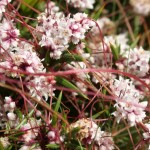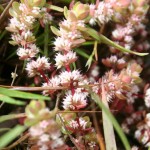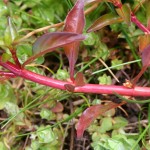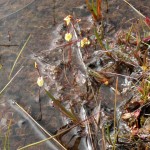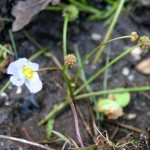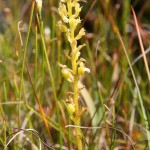The annual coach trip got off to an unpromising start, with driving rain lashing down as we sped southwards. Would this be a repeat of the very wet coach trip to the same area in 2007? At the end of the trip, most people must have agreed with organiser Graham Saunders – it had been one of the best coach trips ever, and he had seen many interesting plants for the first time.
When we reached Hatchet Pond, the rain was still beating down, and we paused to decide what to do. The forecast was for the weather to improve as the day went on. Of the two sites we intended to visit, it was probably more important to have the better weather here than at the other site, so we moved on to Beaulieu Road. In the car park there it was decision time again – we would have a short walk in the rain here, and then have lunch in the coach. In fact, the rain soon abated, and what was to have been a short walk became a much longer one. By lunch time, it was dry enough to eat out of doors, and the afternoon was fine.
The day must have been a bit disappointing for bird-watchers and entomologists – but for the botanists, it was action-packed. Things got interesting straight away, with the fruiting heads of the Wild Gladiolus (Gladiolus illyricus) among the bracken. Heathy areas had Ling (Calluna vulgaris), and here and there, the parasitic Dodder (Cuscuta epithymum) was feeding on it, and flowering. Also present were Bell Heather (Erica carnea), and Heath Milkwort (Polygala serpyllifolia). The bogs were pink with Cross-leaved Heath (Erica tetralix), and there were spikes of Bog Asphodel (Narthecium ossifragum) here and there. Sweet Gale was around (Myrica gale), Lesser Spearwort (Ranunculus flammula), Marsh Pennywort (Hydrocotyle vulgaris), Bog Pimpernel (Anagallis tenella), Lesser Skullcap (Scutellaria minor), Lousewort (Pedicularis sylvatica), and two of the Sundews (Drosera rotundifolia and Drosera intermedia). Wetter areas had Yellow Loosestrife (Lysimachia vulgaris), Water Plantain (Alisma plantago-aquatica), Bogbean (Menyanthes trifoliata) in fruit, and Marsh St. John’s Wort (Hypericum elodes) with its flowers closed up on account of the rain.
In a wooded area, hornets were seen raiding wasp’s nests in holes in an old tree – and the hornets themselves were coming and going from a hole near the base of another old tree, with a large bracket fungus above the entrance to their nest. Some people spotted a Fallow Deer among the trees.
On our way towards lunch, on drier ground, were the diminutive Small Cudweed (Filago minima) and Birdsfoot (Ornithopoides perpusillus), and in a water-filled rut in the track was the extraordinary-looking Coral Necklace (Illecebrum verticillatum).
After lunch by Beaulieu Road, we moved back to Hatchet Pond, in sunshine, with an ice-cream van in attendance. After such a rewarding morning, all we could hope for was more of the same – but no, things got even better, if you didn’t mind scrambling up and down banks, and wading through bogs. We examined Hatchet Pond itself, some of us walking right round it, and a much smaller pond on the other side of the road.
The Fen Bedstraw (Galium uligonosum) was growing virtually on the Hatchet Pond car park, in the company of other damp-loving plants. The smaller pond yielded White Water Lilies (Nymphaea alba), Fringed Water-Lily (Nymphoides peltatus), and an alien from North America , the Pickerel Weed (Pontederia cordata). I’m afraid that the dreaded New Zealand Pigmyweed (Crassula helmsii) was also there, in company with the rare and native Hampshire Purslane (Ludwigia palustris), with tiny flowers in the leaf-axils, and the Lesser Water Plantain (Baldellia ranunculoides).
By the road side between this small pond and the far end of Hatchet Pond, Golden Road (Solidago virgaurea) and Betony (Stachys officinalis) were growing among the heath plants.
Scrambling down a bank to reach a boggy area, a large stand of the Royal Fern (Osmunda regalis) was seen, and the bog itself – not for the faint-hearted! – yielded the Pale Butterwort (Pinguicula lusitanica), one of the Bladderworts (Utricularia), and the Bog Orchid (Hammarbya paludosa), all in full flower.
Thanks are due to the official organisers of this memorable day, and to those who were already familiar with the area, and who enabled the rest of us to make the most of our time in the New Forest .
Report by David Cliffe
Pictures by David Cliffe

